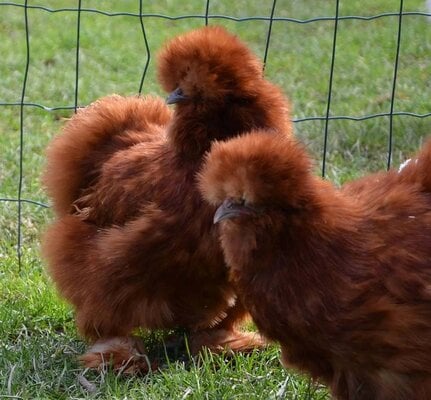hannahsocal
Songster
- Jul 19, 2022
- 158
- 246
- 136
Hello! 
I’m planning on working on a line of red silkies. It seems like there is a lot of confusion out there on the red/buff genetics, so I’m HOPING (
 ) someone can shed some more light on how it actually works. My limited understanding is that buff genes have red diluters and red genes (as in RIRs) have no diluters. Somehow, the buff genetics made a way for the black part of the RIR colouring to disappear. Is there a way to get rid of the black parts of a RIR while keeping the bird all RED and not buff?
) someone can shed some more light on how it actually works. My limited understanding is that buff genes have red diluters and red genes (as in RIRs) have no diluters. Somehow, the buff genetics made a way for the black part of the RIR colouring to disappear. Is there a way to get rid of the black parts of a RIR while keeping the bird all RED and not buff?
My ultimate goal is to create red silkies with no black colouring - basically an even shade of the beautiful RIR colour. Is this genetically possible? I have a nice RIR female I’m planning on using in my F1 gen cross. Should I use a buff Silkie male to cross or a different colour Silkie? Would the buff genes dilute the RIR colouring beyond what is helpful, or would it solve itself when I breed the RIR x buff Silkie F1 cross back to a parent? By breeding the cross back to a buff male though, would that dilute the red? Would it be better to breed a RIR female to a silkie of a non-buff colouring? Maybe a black or something? I’d love some advice on this project if anyone has any! Thanks! I’ve attached a photo I found online of what I’m going for eventually. Not sure if this photo is doctored or if it’s actually possible to breed a beautiful vibrant even shade of red on a Silkie.
I’m planning on working on a line of red silkies. It seems like there is a lot of confusion out there on the red/buff genetics, so I’m HOPING (
My ultimate goal is to create red silkies with no black colouring - basically an even shade of the beautiful RIR colour. Is this genetically possible? I have a nice RIR female I’m planning on using in my F1 gen cross. Should I use a buff Silkie male to cross or a different colour Silkie? Would the buff genes dilute the RIR colouring beyond what is helpful, or would it solve itself when I breed the RIR x buff Silkie F1 cross back to a parent? By breeding the cross back to a buff male though, would that dilute the red? Would it be better to breed a RIR female to a silkie of a non-buff colouring? Maybe a black or something? I’d love some advice on this project if anyone has any! Thanks! I’ve attached a photo I found online of what I’m going for eventually. Not sure if this photo is doctored or if it’s actually possible to breed a beautiful vibrant even shade of red on a Silkie.


